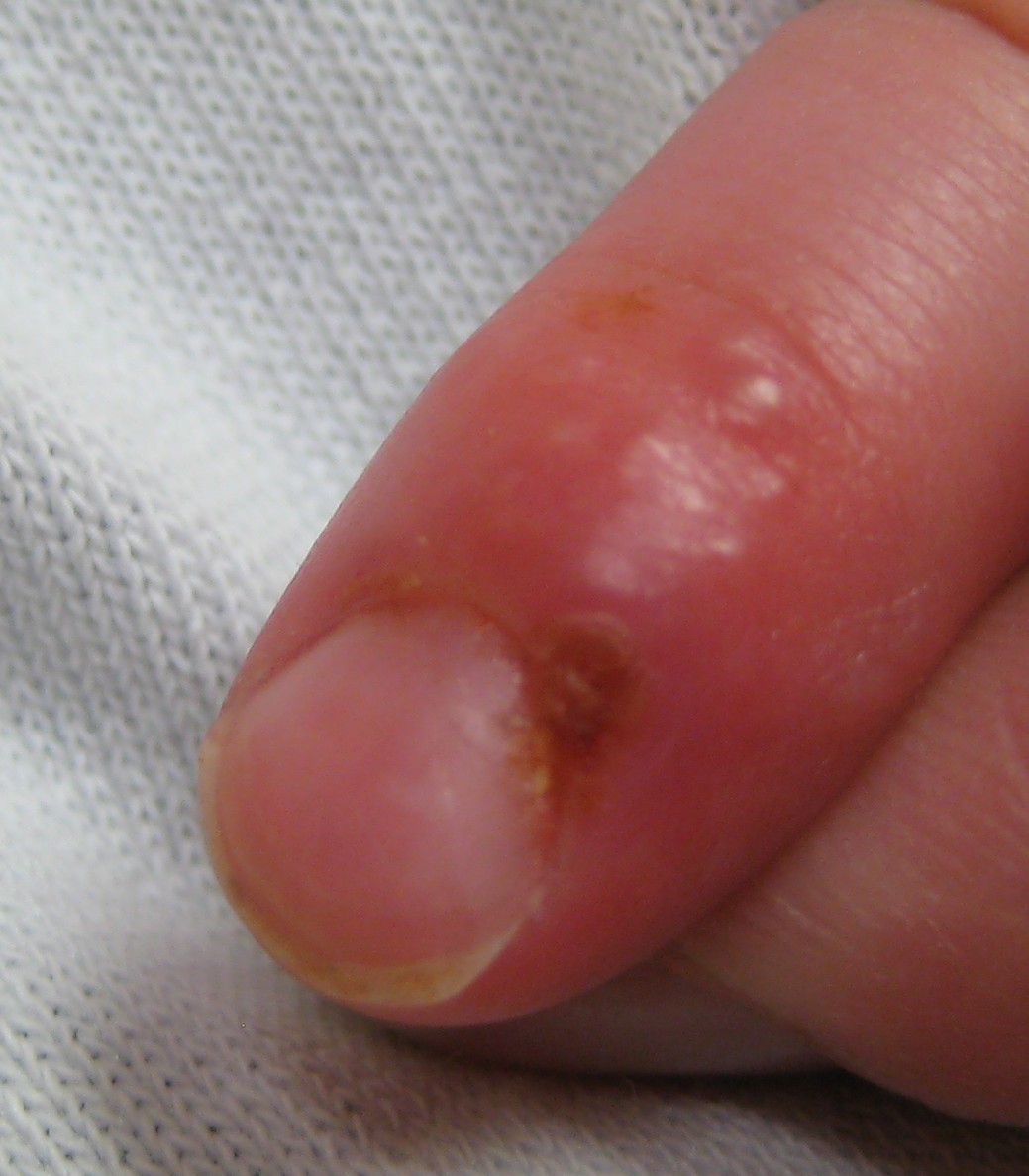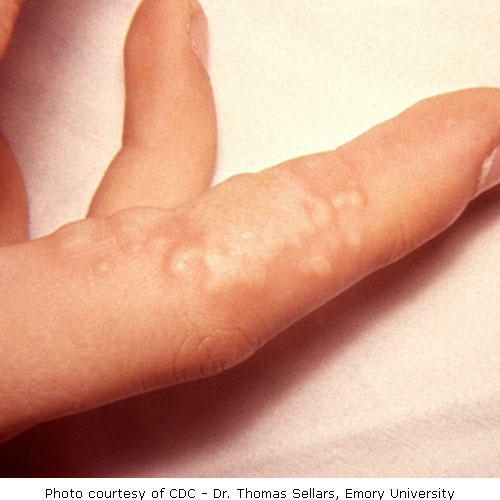Herpetic whitlow: Difference between revisions
No edit summary |
m (Bot: Removing from Primary care) |
||
| (27 intermediate revisions by 10 users not shown) | |||
| Line 1: | Line 1: | ||
__NOTOC__ | |||
{{Herpes simplex}} | |||
{{CMG}} | {{CMG}} | ||
==Overview== | ==Overview== | ||
A | A herpetic whitlow is a lesion on a [[finger]] or [[thumb]] caused by the [[herpes simplex virus]]. In children the primary source of infection is the orofacial area, and it is commonly inferred that the [[virus]] (in this case commonly [[HSV-1]]) is transferred by the chewing or sucking of [[finger]]s or [[thumbs]]. In adults it is more common for the primary source to be the [[genital]] region, with a corresponding preponderance of [[HSV-2]]. It is also seen in adult health care workers such as dentists because increased exposure to the herpes virus. | ||
== | ==Pathophysiology== | ||
*Herpes whitlow | ===Transmission=== | ||
*Herpes whitlow is also caused by [[autoinoculation]] of HSV into broken skin prior to an infected person developing antibodies against the virus (e.g. during primary infection before seroconversion).<ref name="pmid14677662"/> | It is typically contracted by healthcare workers that come in contact with the virus; it is most commonly contracted by dental workers and medical workers exposed to oral secretions.<ref name="pmid15119801">{{cite journal |author=Lewis MA |title=Herpes simplex virus: an occupational hazard in dentistry |journal=Int Dent J |volume=54 |issue=2 |pages=103–11 |year=2004 |pmid=15119801 |doi=}}</ref><ref name="pmid12236568">{{cite journal |author=Avitzur Y, Amir J |title=Herpetic whitlow infection in a general pediatrician--an occupational hazard |journal=Infection |volume=30 |issue=4 |pages=234–6 |year=2002 |pmid=12236568 |doi=}}</ref> Again, the HSV seronegative person is at highest risk of acquiring this condition. It is often observed in thumb-sucking children with primary HSV-1 infection, and in adults aged 20 to 30 following contact with by HSV-2-infected genitals.<ref name="pmid17674583">{{cite journal |author=Wu IB, Schwartz RA |title=Herpetic whitlow |journal=Cutis |volume=79 |issue=3 |pages=193–6 |year=2007 |pmid=17674583 |doi=}}</ref> | ||
==Causes== | |||
*Herpes whitlow is a painful infection that typically manifest itself on fingers or thumbs and occasionally on the toes, or on the nail [[cuticle]], and is caused by HSV-1 or HSV-2.<ref name="pmid14677662">{{cite journal |author=Clark DC |title=Common acute hand infections |journal=Am Fam Physician |volume=68 |issue=11 |pages=2167–76 |year=2003 |pmid=14677662 |doi=}}</ref> | |||
*Herpes whitlow is also caused by [[autoinoculation]] of HSV into broken skin prior to an infected person developing [[antibody|antibodies]] against the virus (e.g. during primary infection before [[seroconversion]]).<ref name="pmid14677662"/> | |||
*If someone has a [[cold sore]] and puts their finger in their mouth then a [[herpes]] infection [[whitlow]] may appear. Herpes whitlows are frequently found among [[dentist]]s and dental hygienists.<ref name="Lewis_2004">{{cite journal | author=Lewis, M.A. | title=Herpes simplex virus: an occupational hazard in dentistry | journal=International Dental Journal | vol=54 | issue=2 | date=April 2004 | pages=103–111 | url=http://www.atypon-link.com/FDI/doi/abs/10.2956/indj.2004.54.2.103 | doi=10.2956/indj.2004.54.2.103}}</ref> | |||
==Natural History, Complications and Prognosis== | |||
The herpes whitlow lesion usually heals in two to three weeks.<ref name="pmid5125276">{{cite journal |author= Anonymous|title=Herpetic whitlow: a medical risk |journal=Br Med J |volume=4 |issue=5785 |pages=444 |year=1971 |pmid=5125276 |doi=}}</ref> | |||
==Diagnosis== | |||
===History and Symptoms=== | |||
Symptoms of herpetic whitlow include [[swelling]], reddening, and [[tenderness]] of the [[skin]] of infected finger. This may be accompanied by [[fever]] and [[swollen lymph nodes]]. | |||
===Physical Examination=== | |||
== | ====Extremities==== | ||
Small, clear [[vesicle]]s initially form that merge and becomes cloudy. Associated pain often seems large relative to the physical symptoms. | |||
<div align="center"> | |||
<gallery heights="175" widths="175"> | |||
Image:Herpeticwhitolow.JPG|Herpetic whitlow in a young child who had earlier developed [[herpes]] [[gingivostomatitis]] | |||
Image:Herpetic whitlow.jpg|[[Vesicular and bullous lesions|Vesiculobullous lesions]] of the fingers of a patient with Herpetic Whitlow | |||
</gallery> | |||
</div> | |||
==Treatment== | ==Treatment== | ||
Although it is a self-limited illness, topical antivirals, particularly topical [[acyclovir]], have been shown to be effective in decreasing the duration of symptoms. One should never try to lance or surgically debride the lesion, as it may make it worse (cause a [[superinfection]] or cause [[encephalitis]]). | ===Medical Therapy=== | ||
Although it is a self-limited illness, [[topical]] antivirals, particularly topical [[acyclovir]], have been shown to be effective in decreasing the duration of symptoms. One should never try to lance or surgically [[debridement|debride]] the lesion, as it may make it worse (cause a [[superinfection]] or cause [[encephalitis]]). | |||
==References== | ==References== | ||
{{reflist|2}} | {{reflist|2}} | ||
{{STD/STI}} | {{STD/STI}} | ||
| Line 29: | Line 44: | ||
{{WH}} | {{WH}} | ||
{{WS}} | {{WS}} | ||
[[Category:Disease]] | |||
[[Category:Sexually transmitted diseases]] | |||
[[Category:Viral diseases]] | |||
[[Category:Dermatology]] | |||
[[Category:Emergency mdicine]] | |||
[[Category:Up-To-Date]] | |||
[[Category:Infectious disease]] | |||
[[Category:Otolaryngology]] | |||
[[Category:Gynecology]] | |||
[[Category:Urology]] | |||
Latest revision as of 22:10, 29 July 2020
|
Herpes simplex Microchapters |
|
Patient Information |
|
Classification |
|
Herpetic whitlow On the Web |
Editor-In-Chief: C. Michael Gibson, M.S., M.D. [1]
Overview
A herpetic whitlow is a lesion on a finger or thumb caused by the herpes simplex virus. In children the primary source of infection is the orofacial area, and it is commonly inferred that the virus (in this case commonly HSV-1) is transferred by the chewing or sucking of fingers or thumbs. In adults it is more common for the primary source to be the genital region, with a corresponding preponderance of HSV-2. It is also seen in adult health care workers such as dentists because increased exposure to the herpes virus.
Pathophysiology
Transmission
It is typically contracted by healthcare workers that come in contact with the virus; it is most commonly contracted by dental workers and medical workers exposed to oral secretions.[1][2] Again, the HSV seronegative person is at highest risk of acquiring this condition. It is often observed in thumb-sucking children with primary HSV-1 infection, and in adults aged 20 to 30 following contact with by HSV-2-infected genitals.[3]
Causes
- Herpes whitlow is a painful infection that typically manifest itself on fingers or thumbs and occasionally on the toes, or on the nail cuticle, and is caused by HSV-1 or HSV-2.[4]
- Herpes whitlow is also caused by autoinoculation of HSV into broken skin prior to an infected person developing antibodies against the virus (e.g. during primary infection before seroconversion).[4]
- If someone has a cold sore and puts their finger in their mouth then a herpes infection whitlow may appear. Herpes whitlows are frequently found among dentists and dental hygienists.[5]
Natural History, Complications and Prognosis
The herpes whitlow lesion usually heals in two to three weeks.[6]
Diagnosis
History and Symptoms
Symptoms of herpetic whitlow include swelling, reddening, and tenderness of the skin of infected finger. This may be accompanied by fever and swollen lymph nodes.
Physical Examination
Extremities
Small, clear vesicles initially form that merge and becomes cloudy. Associated pain often seems large relative to the physical symptoms.
-
Herpetic whitlow in a young child who had earlier developed herpes gingivostomatitis
-
Vesiculobullous lesions of the fingers of a patient with Herpetic Whitlow
Treatment
Medical Therapy
Although it is a self-limited illness, topical antivirals, particularly topical acyclovir, have been shown to be effective in decreasing the duration of symptoms. One should never try to lance or surgically debride the lesion, as it may make it worse (cause a superinfection or cause encephalitis).
References
- ↑ Lewis MA (2004). "Herpes simplex virus: an occupational hazard in dentistry". Int Dent J. 54 (2): 103–11. PMID 15119801.
- ↑ Avitzur Y, Amir J (2002). "Herpetic whitlow infection in a general pediatrician--an occupational hazard". Infection. 30 (4): 234–6. PMID 12236568.
- ↑ Wu IB, Schwartz RA (2007). "Herpetic whitlow". Cutis. 79 (3): 193–6. PMID 17674583.
- ↑ 4.0 4.1 Clark DC (2003). "Common acute hand infections". Am Fam Physician. 68 (11): 2167–76. PMID 14677662.
- ↑ Lewis, M.A. (April 2004). "Herpes simplex virus: an occupational hazard in dentistry". International Dental Journal (2): 103–111. doi:10.2956/indj.2004.54.2.103. Unknown parameter
|vol=ignored (|volume=suggested) (help) - ↑ Anonymous (1971). "Herpetic whitlow: a medical risk". Br Med J. 4 (5785): 444. PMID 5125276.

